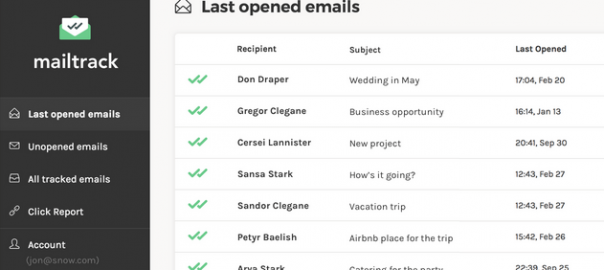— January 16, 2019
Need to make sales, quick, but you despise cold calling?
Not a problem—there’s a better solution that doesn’t elevate your blood pressure nor increase the billable hours of your psychotherapist. It’s none other than email prospecting; a proven strategy that can work miracles, if and only if it’s executed correctly.
According to eConsultancy, to out of three marketers rate their email return on investment as either good…or excellent! But before you queue that perfectly-crafted message and fire it off to your prized database, ask yourself: “Will it make much sense to spend hours, days, weeks and even months emailing these people, just to hear crickets when I check my inbox?”
Seeing only, “sorry, this email couldn’t be delivered” messages in your inbox? No, it doesn’t make much sense at all, and it’s something you can steer clear of. Get prepared to join the 66% of marketing professionals getting huge ROI from their email campaigns, by doing these 7 things, before hitting “send.”
1. Shorten That Subject Line
Depending on your industry, it’s likely your prospects are checking some of their emails from a smartphone. And as anyone using such a small device can attest, you have a very limited amount of screen real estate to get your message across.
As a matter of fact, you have just a few words to make that happen, because your subject line is the first thing Johnny Businessman will see. If that title is too long to fit his vertically-positioned screen in its entirety, he just might delete it. One best practice to avoid this issue is to make sure the complete subject line can be seen at a glance.
One of MailChimp’s representatives agrees, saying, “For most users, there is no statistical link between subject line length and open rate. But for subscribers reading your campaigns on mobile devices, shorter may be better.”
2. Remove Spam Trigger Fodder
Following the best advice to a tee will do nothing to help you, if words commonly known to trigger spam filters are being used in your messages. If at all possible, remove any words known to trigger spam filters from your messages. Below is a list of trigger words Hubspot has found to be detrimental, when used in email marketing campaigns.
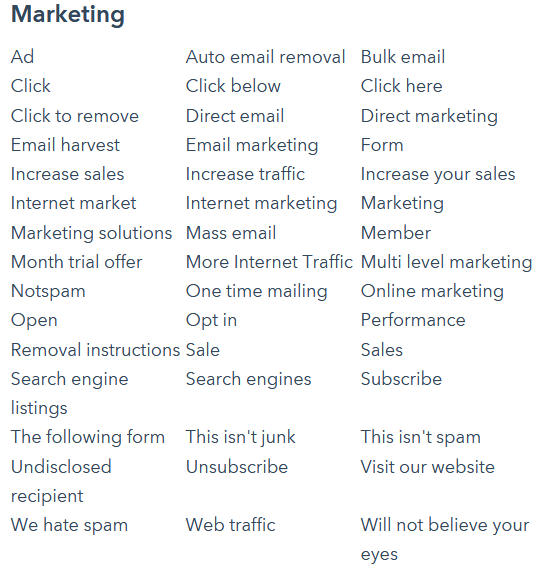
Source: Hubspot
Another useful tool to keep you out of the spam traps and boost your prospecting ROI, is Mailchip’s subject line tool, which can help identify words that may help or hinder your email deliverability.
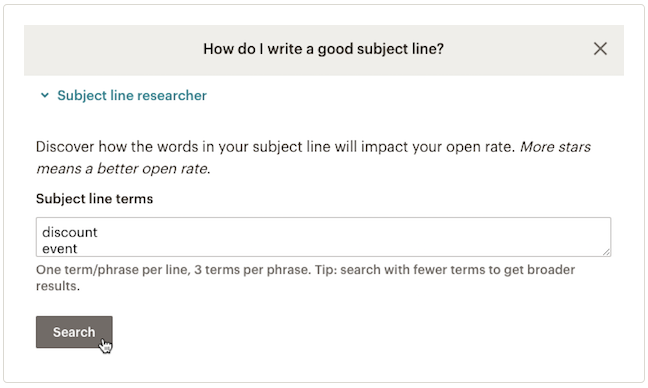
Source: Mailchimp
3. Save the Commitment for Marriage
Successful prospecting email requires some sort of call-to-action that not only guides your reader to making a decision, but which also brings you closer to sealing the deal. However, that rarely happens on the first email or subsequent email follow-ups until the prospect’s trust level increases, or unless there’s a clear need for your offering.
Remove any pressure or intimidating commitment on the recipient’s behalf. Asking the recipient to make a purchase today or book an appointment with you this week, will surely rub her the wrong way— and may cause her to push that unforgiving “spam” button.
While it’s true the responses you get back will be far and few between, even when doing everything correctly, it’s counterproductive to lower it even more, by placing unrealistic expectations on the already-overworked person reading your email.
4. Remove That General Mailbox or Gatekeeper’s Address
*Remove that “info@” address and hunt for a decision maker’s email address until you get weary. Don’t take the lazy route and blast off emails to an info@ or contact@ address, although it can be tempting and time saving. As far as you know, those emails arrive in a fiery pit of digital hell, never to be seen or heard from again.
The person fielding messages sent to general inboxes are often unqualified to address them. They typically have no authority to make decisions, or they’re too busy to figure out to whom it should be forwarded, and will ignore or delete it—without blinking or losing sleep. I shared a bit of insight explaining how to find a decision maker’s email address here, in case you need it.
5.) Reduce Those Paragraphs to Less Than 200 Words
Essays disguised as email are outright bad for business. People are busier than ever nowadays; they’re impatiently sifting through cluttered inboxes, in search of messages worth reading. Emails not fitting that bill will be promptly overlooked or ignored, if not send to the trash bin immediately. Being greeted by paragraphs of text if they choose to open yours, won’t help get you closer to that dotted line being signed.
Recent data from Boomerang found emails with 75-100 words had the highest response rates, with more than 50% of recipients responding the emails. While that data suggests you condense your emails to less than 200 words, it’s good practice to format your text with ample white space, to improve the readability of your emails. I typically limit my emails to 125 words or less, but your mileage will vary.
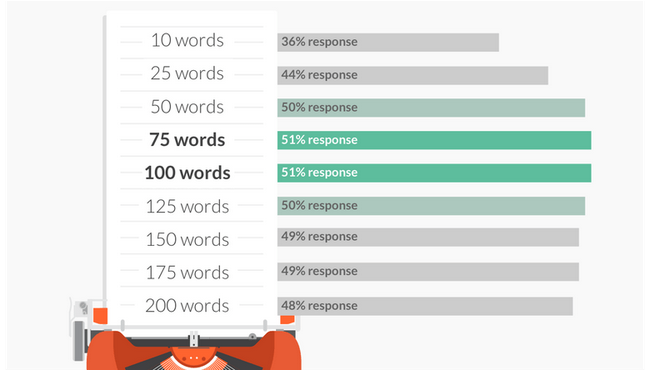
Source: Boomerangapp.com
6. Refrain from Using Subject Line Gimmicks
Don’t learn the hard way. That subject line you’re banking on may seem clever, but in many cases, clever is just a synonym for deleted. While crafting the perfect subject line requires you teeter the fine line between invoking curiosity and being disregarded as a ploy, it’s very easy to get the opposite reaction instead of that which you intended.
Here are some examples of subject line ruses to avoid at all costs:
“Re: Our conversation last week”
…when in fact, this is the very first time you’ve made contact with the person.
“Referred to you by Mary in sales”
…actually, Mary didn’t refer you and even worse: there is no Mary in the company.
“Can I work for you for free?”
…he soon realizes after reading, only the last month is free, after they’ve paid $ 1,999.35 for 5 months.
7. Get a Tracking Solution Before Hitting ‘Send’
Sending emails to your prospects without knowing if and when they’ve read them, is equivalent to shooting mosquitoes in a barrel—blindfolded, at night, with a gun that jams every other shot. Maximizing the opportunities you’ll come across can only happen if you have data to support each and every decision made.
- Was my email delivered successfully?
- Was my email ever opened?
- What time and day was it read?
Those are important question by which your prospecting campaign lives or dies. When you know an email has been successfully delivered and read, you can queue the follow-up messages that are relevant to the reader, at the right time. Furthermore, it’s much easier to segment your prospects in groups—categorizing prospects by those who’ve read the messages, and those who haven’t.
Your follow-ups can then be customized with different messages tailored to prospects who’ve read your emails, and the stragglers who haven’t opened them. In the two email intro sentences below, can you tell which example might garner a response from a prospect?
Example 1:
“Hi Jane, I sent you an email last Friday, but I don’t know if you had the chance to read it yet…”
Example 2:
“Hi Jane, I’m following up because I noticed you haven’t had a chance to read the email I sent last Friday..”
If you guessed example#1—winner, winner, expensive dinner (soon)!
To track your emails relentlessly and increase your chances of closing more deals or booking more appointments, myself and numerous others highly recommend Mailtrack as your go-to solution. They have several pricing options, including a free version—and it’s a tool that my digital agency wouldn’t be caught without.
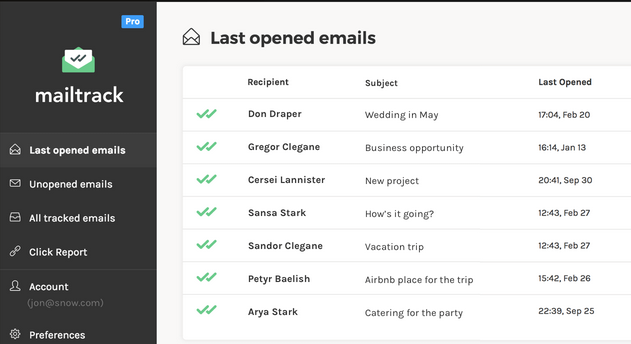
Source: Mailtrack
It works with Google Chrome and integrates seamlessly with Gmail, allowing you the option of using a Gmail account or a private domain. Don’t bother sending prospecting emails without using Mailtrack, or a competing solution that’s just as capable.
Ready, Aim, Send!
Now that you’re armed with 7 best practices for prepping those potential deal makers, apply them immediately—and watch your response rates increase significantly.
Digital & Social Articles on Business 2 Community
(88)
